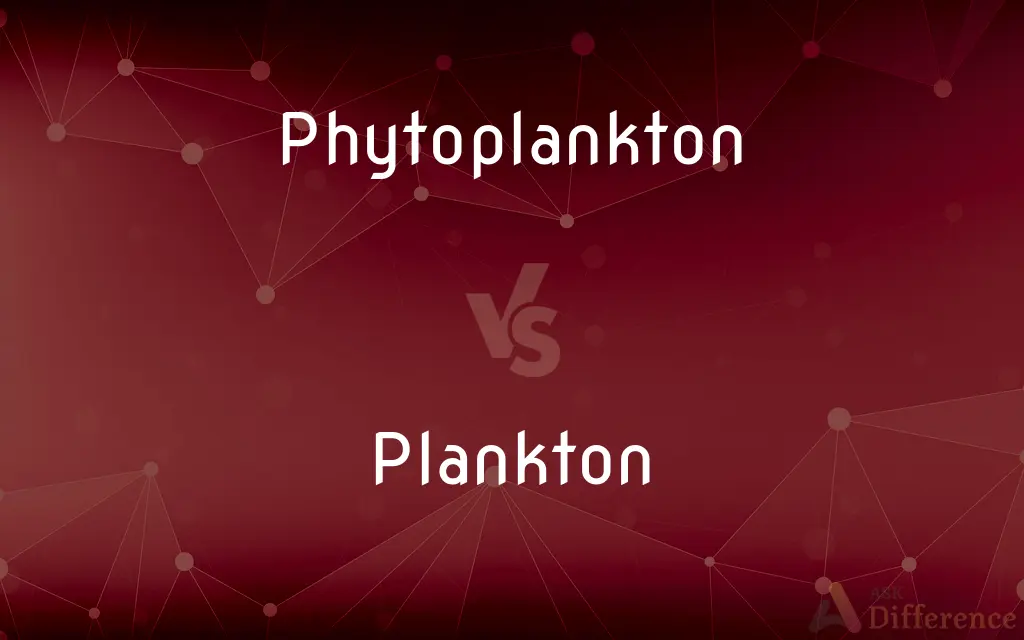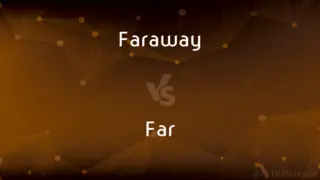Phytoplankton vs. Plankton — What's the Difference?
Edited by Tayyaba Rehman — By Fiza Rafique — Updated on April 16, 2024
Phytoplankton are microscopic, photosynthetic organisms within the broader category of plankton, which includes both microscopic plants and animals.

Difference Between Phytoplankton and Plankton
Table of Contents
ADVERTISEMENT
Key Differences
Phytoplankton are primarily microscopic marine organisms that perform photosynthesis, much like terrestrial plants. On the other hand, plankton is a more inclusive category that comprises all organisms drifting in water bodies, including both phytoplankton and zooplankton.
Phytoplankton are crucial for the marine food web as they are primary producers, converting sunlight and carbon dioxide into energy. Whereas, plankton includes consumers like zooplankton, which feed on phytoplankton and other small particles.
Phytoplankton is predominantly found in the sunlit upper layers of water where photosynthesis can occur. In contrast, plankton can be found throughout various depths of the water column, depending on the species and environmental conditions.
Phytoplankton populations are closely monitored as they impact carbon cycling and climate regulation. On the other hand, studying plankton in general helps scientists understand ecological dynamics, including food web structures and nutrient cycles.
Phytoplankton blooms can significantly affect marine environments by producing oxygen and sometimes toxins. Conversely, plankton dynamics, including those of zooplankton, play key roles in biogeochemical cycles and can influence water quality.
ADVERTISEMENT
Comparison Chart
Definition
Microscopic, photosynthetic organisms in water.
Drifting organisms in water, including plants and animals.
Role in Ecosystem
Primary producers, convert sunlight and CO2 to energy.
Varying roles from producers to consumers.
Types
Includes only photosynthetic organisms.
Includes both phytoplankton and zooplankton.
Habitat
Predominantly upper water layers.
Found throughout various water depths.
Ecological Importance
Crucial for marine food webs and carbon cycling.
Important for ecological dynamics and nutrient cycles.
Compare with Definitions
Phytoplankton
Photosynthetic marine microorganisms.
Diatoms are a type of phytoplankton that contribute significantly to oxygen production.
Plankton
Found in all aquatic environments.
Plankton are present in freshwater lakes, rivers, and the ocean.
Phytoplankton
Influencers of global climate.
Phytoplankton sequester carbon dioxide, playing a role in climate regulation.
Plankton
Diverse group of drifting organisms.
Plankton can include anything from microscopic algae to jellyfish larvae.
Phytoplankton
Base of the aquatic food web.
Many marine species, like small fish and whales, rely on phytoplankton for food.
Plankton
Subject to research for ecological insights.
Scientists study plankton to understand more about biodiversity and ecological health.
Phytoplankton
Subject to population booms.
Phytoplankton blooms can sometimes lead to harmful algal blooms.
Plankton
Variable in size.
Some plankton are nearly invisible, while others, like jellyfish, can be seen with the naked eye.
Phytoplankton
Studied for environmental health indicators.
Changes in phytoplankton populations can indicate shifts in environmental conditions.
Plankton
Crucial for biodiversity.
Plankton diversity is key to healthy aquatic ecosystems.
Phytoplankton
Phytoplankton () are the autotrophic (self-feeding) components of the plankton community and a key part of ocean and freshwater ecosystems. The name comes from the Greek words φυτόν (phyton), meaning 'plant', and πλαγκτός (planktos), meaning 'wanderer' or 'drifter'.Phytoplankton obtain their energy through photosynthesis, as do trees and other plants on land.
Plankton
Plankton are the diverse collection of organisms found in water (or air) that are unable to propel themselves against a current (or wind). The individual organisms constituting plankton are called plankters.
Phytoplankton
Plankton that consists of minute plants and other photosynthetic organisms, including cyanobacteria, diatoms, and dinoflagellates.
Plankton
The small or microscopic organisms that drift or swim weakly in a body of water, including bacteria, diatoms, jellyfish, and various larvae. Plankton is an important food source for fish and other larger organisms.
Phytoplankton
Plankton, especially those small in size, that obtain energy by photosynthesis.
Plankton
(uncountable) Organisms, especially small and microscopic ones, that drift in water.
Phytoplankton
Photosynthetic or plant constituent of plankton; mainly unicellular algae
Plankton
(uncountable) A plankter, any single organism that drifts in water.
Plankton
All the animals and plants, taken collectively, which live at or near the surface of salt or fresh waters.
Plankton
The aggregate of small plant and animal organisms that float or drift in great numbers in fresh or salt water
Common Curiosities
What is plankton?
Plankton refers to all organisms, plant or animal, that drift in water currents, encompassing a wide range of sizes and species.
What is the difference between phytoplankton and algae?
Phytoplankton are a type of microscopic algae, specifically adapted to living suspended in water columns.
Are there freshwater plankton?
Yes, there are many types of plankton that live in freshwater environments, including both phytoplankton and zooplankton.
What is phytoplankton?
Phytoplankton are microscopic, photosynthetic organisms in aquatic environments, essential as the base of the marine food web.
How do phytoplankton contribute to the ecosystem?
Phytoplankton produce oxygen and form the primary food source for many marine organisms, impacting the entire marine ecosystem.
What happens during a plankton die-off?
A plankton die-off can lead to reduced oxygen levels in water, affecting fish and other marine life.
How do temperature changes affect phytoplankton?
Temperature changes can influence their growth rates and distribution, potentially causing shifts in marine ecosystems.
Can plankton be seen with the naked eye?
Some plankton, like certain types of jellyfish and krill, are large enough to be seen without magnification, but many are microscopic.
How do plankton survive in water?
Plankton drift with water currents; many have adaptations like flagella or cilia to help them move or stay suspended in water.
What types of organisms are included in plankton?
Plankton includes a variety of organisms, from microscopic algae (phytoplankton) to animal plankton (zooplankton) and even larval stages of larger animals.
Why are phytoplankton important to study in terms of climate change?
They play a significant role in carbon sequestration and can influence global climate patterns.
How do phytoplankton affect marine animals?
They are a primary food source for many marine animals and influence the health of marine ecosystems.
What causes a phytoplankton bloom?
Phytoplankton blooms are typically caused by an abundance of nutrients in the water, often coupled with favorable sunlight and temperature conditions.
What research methods are used to study plankton?
Scientists use methods like microscopy, satellite imaging, and water sampling to study the distribution and types of plankton.
Do all plankton photosynthesize?
No, only the phytoplankton photosynthesize; zooplankton are consumers that feed on other plankton or organic material.
Share Your Discovery

Previous Comparison
Gomoku vs. Go
Next Comparison
Faraway vs. FarAuthor Spotlight
Written by
Fiza RafiqueFiza Rafique is a skilled content writer at AskDifference.com, where she meticulously refines and enhances written pieces. Drawing from her vast editorial expertise, Fiza ensures clarity, accuracy, and precision in every article. Passionate about language, she continually seeks to elevate the quality of content for readers worldwide.
Edited by
Tayyaba RehmanTayyaba Rehman is a distinguished writer, currently serving as a primary contributor to askdifference.com. As a researcher in semantics and etymology, Tayyaba's passion for the complexity of languages and their distinctions has found a perfect home on the platform. Tayyaba delves into the intricacies of language, distinguishing between commonly confused words and phrases, thereby providing clarity for readers worldwide.
















































